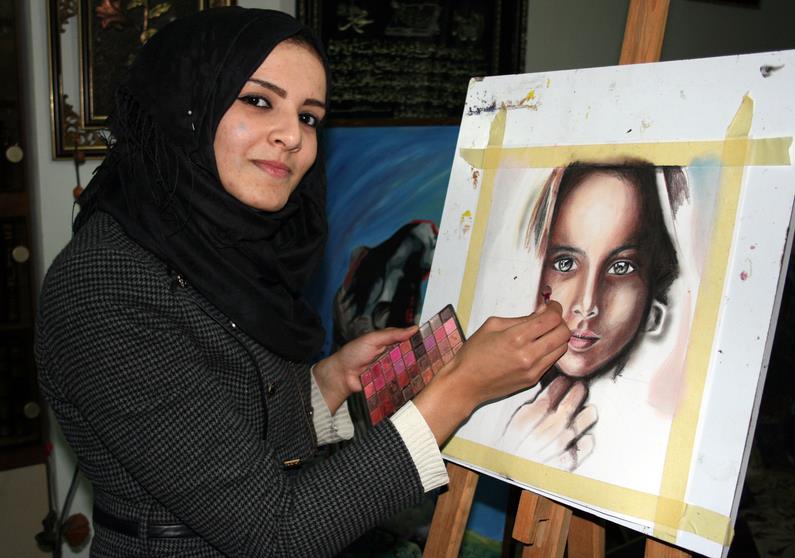
Palestinian artists reject violence favour creative protest
Khan Yunis Gaza: The woman stares out of the picture with an empty gaze her face disfigured by cuts.
She wears a headscarf and traditional Palestinian robes and appears to be playing an olive branch with a feather as if it were a violin.
In the background Jerusalem's Dome of the Rock is visible.
"We are not living a normal life like all the people all over the world" says the artist Kholoud Mohammed el-Desoki who lives in the Gaza Strip.
And like most Palestinians she blames Israel for that.
But the 23-year-old who lives in the city of Khan Yunis has decided to reject violence in favour of creative protest.
Since the beginning of October Palestinians most of them young and from the West Bank have been carrying out stabbing attacks on Israelis.
In Gaza meanwhile Palestinians have been clashing with the armed forces with many shot dead.
The violence was largely triggered by a dispute over prayer rights on Temple Mount where the Dome of the Rock is also located.
"We have in Gaza 200 to 400 artists at different levels" says Sherif Serhan director of the Shababek Arts Association in Gaza.
"A lot of artists make art-work to explain to international people the political situation in Gaza and the living situation in Gaza" he says.
Some tackle the problems between Israel and Gaza others the problems between rival Palestinian political parties mainly the radical Hamas in the Gaza Strip and the more moderate Fatah in the West Bank.
El-Desoki studied art in Gaza. As a young girl she painted pictures in which she highlighted the right of Palestinians to repossess the homes in Israel that once belonged to their forefathers.
"Every Palestinian has to call for the right of return" says el-Desoki who wears a black headscarf and a long black dress.
In the months before and after the Israeli declaration of independence in May 1948 and in the subsequent war more than 700000 Palestinians fled or were driven from their homes in present-day Israel.
But Israel has consistently rejected the Palestinians' right to return because it believes that would threaten the existence of the Jewish state.
El-Desoki is currently working on a portrait of a young girl wearing a headscarf. It's meant to be an allegory for poverty.
She paints with blusher and lipstick kohl and eyeshadow.
"I really wanted to use something which nobody used before" she says.
Aside from that oil paints have become too expensive because of the Israeli blockade; Israel has been blockading the Gaza Strip since Hamas seized control of it in 2007.
Ayman Mghamis is also rebelling through his art. He started making music in 2001 during the second Intifada or uprising of the Palestinians against the Israelis.
"It was a horrible situation" says the 30-year-old rapper. "We wanted to do something away from the violence."
He started listening to Afro-American rap and felt that it reflected the way he felt about the situation in Israel and the Palestinian Territories.
In his music he raps about the Israeli occupation but also about life in general in Gaza and the high rate of unemployment.
His song Gaza Poster is melodious and filled with longing while the video shows young men among ruins alongside the sea.
"I want to live in a place where I can say 'No' without being hurt" he says. "I want to live and die normally."
Mghamis also criticizes Hamas - indirectly at least.
"I fear for my family for my daughter" he says. Last year Hamas questioned him for five hours about his music.
"They just wanted to show me 'We are here and we are watching you'" he says.
An attempt to move abroad with his family failed though in March he is to present his new album in France.
His musical colleague Monem Awad is significantly more aggressive in his songs.
In his current video Intifada he shows clips of stone-throwing and a burning Palestinian flag.
He raps about what triggered the current "stabbing intifada" including the deadly arson attack by West Bank settlers on a Palestinian family home last year.
The violence has now created a momentum of its own.
"If it is against soldiers I support it. If it is against civilians not" says 25-year-old Awad who has also trained as a nurse.
He too wants to leave the Gaza Strip and travel to Spain to study - his brother has already left for Norway.
dpa

Legal Disclaimer:
MENAFN provides the
information “as is” without warranty of any kind. We do not accept
any responsibility or liability for the accuracy, content, images,
videos, licenses, completeness, legality, or reliability of the information
contained in this article. If you have any complaints or copyright
issues related to this article, kindly contact the provider above.


















Comments
No comment